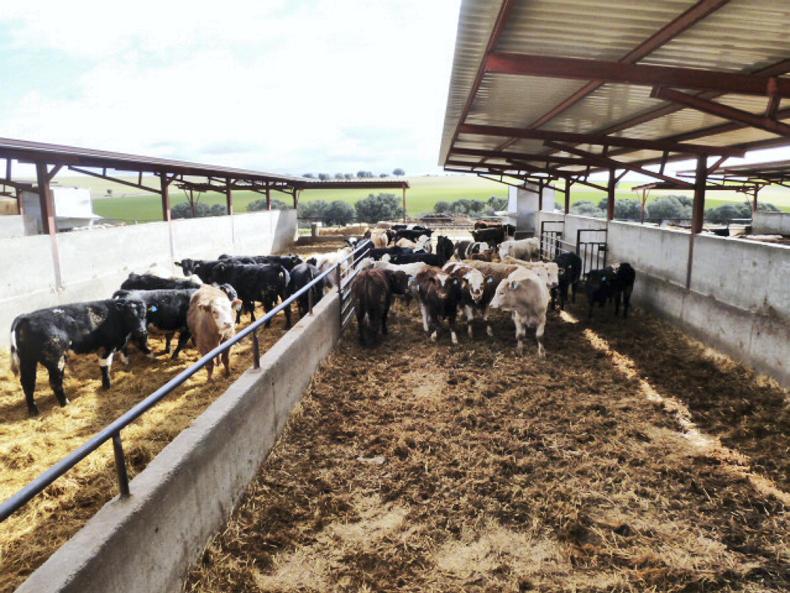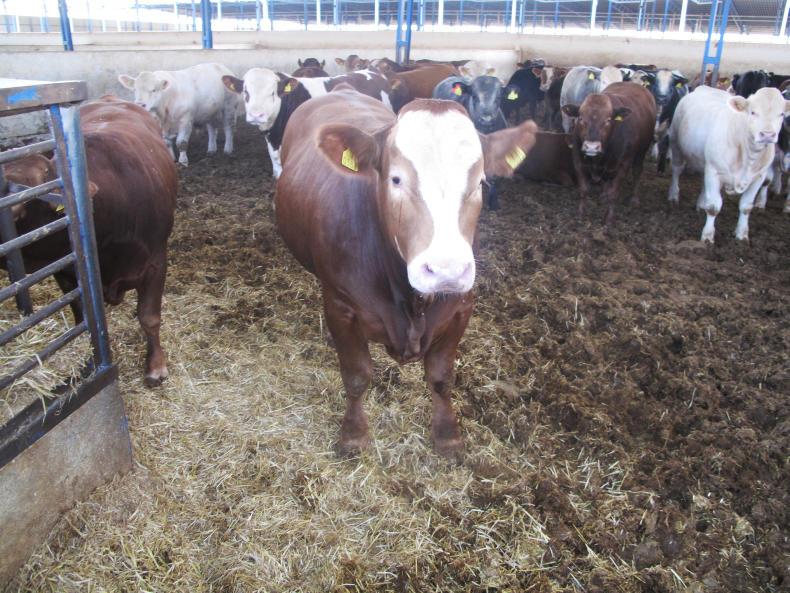There has been a change of fortunes in the Spanish beef sector following a period of significant volatility during the country’s financial crisis, which hit in 2008.
Recovery in the sector, which produced 640,000t of beef in 2016 and imported a massive 584,000 cattle live, is being boosted by growth in live cattle exports to third countries and an improvement in the Spanish economy.
In the latest Bord Bia Food Alert, Cecilia Ruiz from the Bord Bia Madrid office said import and export dynamics are an important component of the Spanish beef production system, which totals 6.18m head (1.9m suckler cows and 0.84m dairy cows).
As detailed in in the table below, Spain exported just shy of 150,000 head of cattle in 2016, with 76.6%, or 114,565 head, exported outside the EU.
Growth in this export avenue has continued, with live exports up until August 2017 surpassing the total figure for 2016 and standing at about 120,000 head.
The chart above gives a breakdown of the four key Spanish export markets. Libya dominated demand this year, importing some 42,821 cattle followed by 28,806 head to Lebanon.
Like Ireland, Spain has also benefited from the absence of French cattle in the Turkish market and up to August exported 13,623 head to market.

Demand for cattle has been boosted by a recovery in domestic beef demand and higher live exports to third-country markets.
Live exports to third countries returned an average price per head of €1,280.
According to Cecilia, at this level, the outlet is more profitable than selling animals to Spanish factories. The market is paying €2.30/kg to €2.40/kg for continental-cross animals weighing between 600kg and 660kg, while Friesian cattle weighing 300kg to 400kg are returning an average price of €1.75/kg.
The beef price in Spain has improved and is in the region of €4.10/kg to €4.15/kg for R+ and U grading cattle at 360kg to 380kg carcase weight, with bulls finished intensively between 10 and 16 months of age. For the EU, the main live export markets are Italy (15,000 head) France (6,000 head) and Portugal (3,000 head).
Live imports
The vibrancy in the export market has also gradually cut the number of calves exported from Spain, with feeders opting to add value by bringing calves to store and slaughter stage.
The table below details Spanish exports for the period 2011 to 2016, showing an increase of over 217,000 head in the last five years.
Growth has stemmed from two avenues, imports of calves less than 80kg and imports of young cattle weighing between 160kg and 300kg. The chart below shows countries supplying calves and as can be readily seen France and Germany are the two main suppliers with Irish calf exports amounting to just 6% of imports in 2016.
Ireland has capitalised on some of this import opportunity in 2017, with calf exports for the year to date rising 10,827 head or 33% to reach 43,400.
Weanling exports, at 1,902 head, are on a par to the total number exported in 2016.
The Spanish market for cattle weighing from 160kg to 300kg is dominated by French cattle at 82% of total imports, as reflected in the chart below.
Growing Irish exports
Cecilia says the focus for Bord Bia in the Spanish market is to continue to develop greater opportunities for Irish imports through collaboration and event sponsorship with Asoprovac, the organisation that represents Spanish feedlot owners, and also through livestock advertising and networking at the main sector events.
Read more
Clare Marts planning terminal breeding suckler scheme
Exclusive: latest Mercosur beef offerings
ICBF stockbull finder off to a strong start
There has been a change of fortunes in the Spanish beef sector following a period of significant volatility during the country’s financial crisis, which hit in 2008.
Recovery in the sector, which produced 640,000t of beef in 2016 and imported a massive 584,000 cattle live, is being boosted by growth in live cattle exports to third countries and an improvement in the Spanish economy.
In the latest Bord Bia Food Alert, Cecilia Ruiz from the Bord Bia Madrid office said import and export dynamics are an important component of the Spanish beef production system, which totals 6.18m head (1.9m suckler cows and 0.84m dairy cows).
As detailed in in the table below, Spain exported just shy of 150,000 head of cattle in 2016, with 76.6%, or 114,565 head, exported outside the EU.
Growth in this export avenue has continued, with live exports up until August 2017 surpassing the total figure for 2016 and standing at about 120,000 head.
The chart above gives a breakdown of the four key Spanish export markets. Libya dominated demand this year, importing some 42,821 cattle followed by 28,806 head to Lebanon.
Like Ireland, Spain has also benefited from the absence of French cattle in the Turkish market and up to August exported 13,623 head to market.

Demand for cattle has been boosted by a recovery in domestic beef demand and higher live exports to third-country markets.
Live exports to third countries returned an average price per head of €1,280.
According to Cecilia, at this level, the outlet is more profitable than selling animals to Spanish factories. The market is paying €2.30/kg to €2.40/kg for continental-cross animals weighing between 600kg and 660kg, while Friesian cattle weighing 300kg to 400kg are returning an average price of €1.75/kg.
The beef price in Spain has improved and is in the region of €4.10/kg to €4.15/kg for R+ and U grading cattle at 360kg to 380kg carcase weight, with bulls finished intensively between 10 and 16 months of age. For the EU, the main live export markets are Italy (15,000 head) France (6,000 head) and Portugal (3,000 head).
Live imports
The vibrancy in the export market has also gradually cut the number of calves exported from Spain, with feeders opting to add value by bringing calves to store and slaughter stage.
The table below details Spanish exports for the period 2011 to 2016, showing an increase of over 217,000 head in the last five years.
Growth has stemmed from two avenues, imports of calves less than 80kg and imports of young cattle weighing between 160kg and 300kg. The chart below shows countries supplying calves and as can be readily seen France and Germany are the two main suppliers with Irish calf exports amounting to just 6% of imports in 2016.
Ireland has capitalised on some of this import opportunity in 2017, with calf exports for the year to date rising 10,827 head or 33% to reach 43,400.
Weanling exports, at 1,902 head, are on a par to the total number exported in 2016.
The Spanish market for cattle weighing from 160kg to 300kg is dominated by French cattle at 82% of total imports, as reflected in the chart below.
Growing Irish exports
Cecilia says the focus for Bord Bia in the Spanish market is to continue to develop greater opportunities for Irish imports through collaboration and event sponsorship with Asoprovac, the organisation that represents Spanish feedlot owners, and also through livestock advertising and networking at the main sector events.
Read more
Clare Marts planning terminal breeding suckler scheme
Exclusive: latest Mercosur beef offerings
ICBF stockbull finder off to a strong start







 This is a subscriber-only article
This is a subscriber-only article










SHARING OPTIONS: